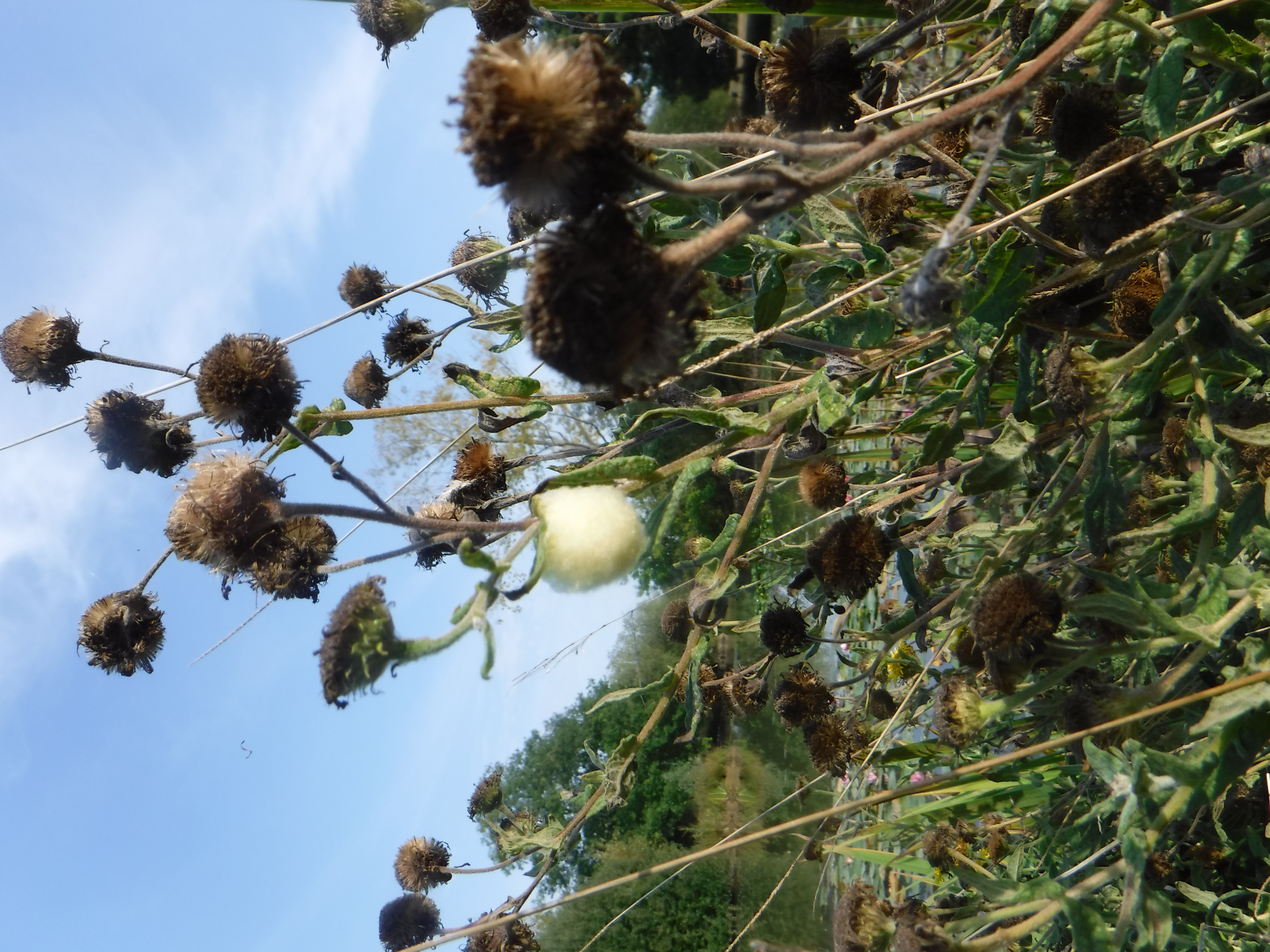
Total monthly rainfall: 27 millimetres. Maximum daily rainfall: 12.5 millimetres on 25th September.
The nine days between September 23rd and 30th had 100% cloud-cover for at least part of the day, plus a further two days on the 3rd and 7th.
Maximum temperature on the warmest day was 29°C on September 15th, and on the coldest days was 12°C on the 26th and 27th.
Strong winds between the 24th and 27th brought down one large goat willow tree and many leaves and small branches.
Having colder weather at the start of meteorological autumn, and with end of season sheep grazing reducing the number of wildflower species on site, we are left with only common fleabane, knapweed, yarrow, oxeye daisy, common daisy, dandelion, rough hawkbit, red and white deadnettle, red clover, water-mint, redshank, nipplewort, bird’s foot trefoil, speedwell, mayweed, and Canadian fleabane.
-
 Knotgrass caterpillar on rushes
Knotgrass caterpillar on rushes
Knotgrass caterpillar on rushes
Knotgrass caterpillar on rushes
-
 Light emerald moth on meadow grass
Light emerald moth on meadow grass
Light emerald moth on meadow grass
Light emerald moth on meadow grass
-
 Square spot rustic moth indoors
Square spot rustic moth indoors
Square spot rustic moth indoors
Square spot rustic moth indoors
-
 Unidentified cocoon on fleabane
Unidentified cocoon on fleabane
Unidentified cocoon on fleabane
Unidentified cocoon on fleabane
https://www.kentfieldclub.org.uk/news/little-barton-farm-wildlife-notes/nature-notes-september-2020#sigProId32b364f306
There were no new butterfly species seen this month but there were at least 4 more species of moth. On September 2nd we rescued a brimstone moth from a dog’s drinking bowl, while on the 9th a square-spot rustic came to light in our upstairs bathroom (identified from our photograph by Keith Palmer). The 10th found an early thorn moth to light in the same bathroom, plus a second-generation light-emerald moth among grasses in the wildflower meadow. On the 30th we discovered a knotgrass caterpillar among lake-side rushes.
On September 20th we discovered the first of four small creamy-yellow cocoons on common fleabane. Our internet search proved to be inconclusive, so we have enlisted the help of KMBRC, and, a week later, John and Gill Brook – who were County dragonfly recorders and had other wildlife-recorder contacts across the country.
On September 11th we spotted a garden spider in its web among lake-side rushes, plus what proved to be a strong second generation of crane-flies from the 26th. Among them was a first-sighting of a long-legged crane-fly called Tipula rufina or stegari, indoors to any open window, and difficult to tell apart from each other. On the 28th we found our first devil’s coach horse among stored logs.
Our reptile shelters have revealed 2 slow worms and a grass snake on September 3rd, and 2 wood mice on the 13th. For much of this year we have found very little beneath these shelters as the heat has been too intense beneath them.
Fungi have been slow to appear because of the dry summer, but we found common funnel beside the lake on September 3rd and red-cracking bolete on the back lawn on the 5th. We are still awaiting parasol mushrooms, although we have gathered a few field mushrooms on and after the 28th.
Signs of the development of autumn among shrubs and trees were as follows:- Field maple first yellow-tinted leaves on September 19th; Poplar full yellow tint and horse chestnut first brown tint (21st); hops ripe and gathered for decoration on a misty 22nd; first yellow tinting on ash trees on the 27th, and first holly berries ripe on the 30th.
Last month’s wasps had cleverly constructed their nest in a hazel bush within metres of our apple tree. There were fewer apples than last year, but they were much larger than normal. However, before they were ripe, the wasps were attacking them, and were joined by crows and moorhens scoffing apples among the upper branches. Susan crept out and tried to photograph the moorhens, but without success as they always flew off.
There were 2 first-sighting of a wild bird species this month, including two grey-lag geese among 75 canada geese on the 6th, and 2 grey wagtails at the woodland ponds on September 23rd. The grey wagtails were still present at the end of the month, and foraged on the dried-up bed of the ponds around the outer edge of the present water-level. This brings our current total for the year to 47.

